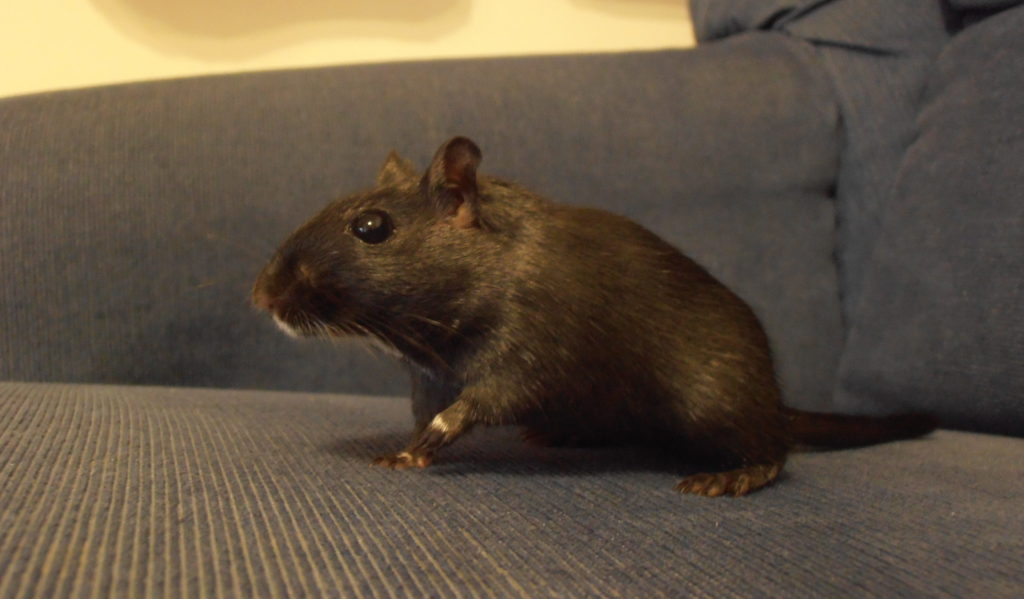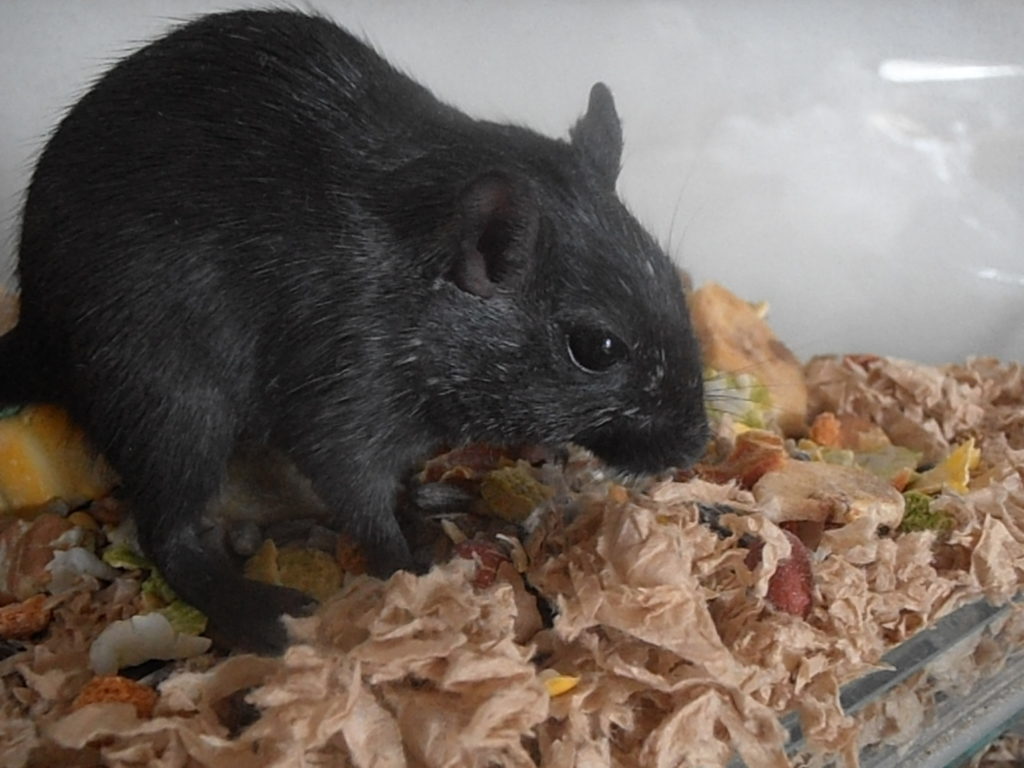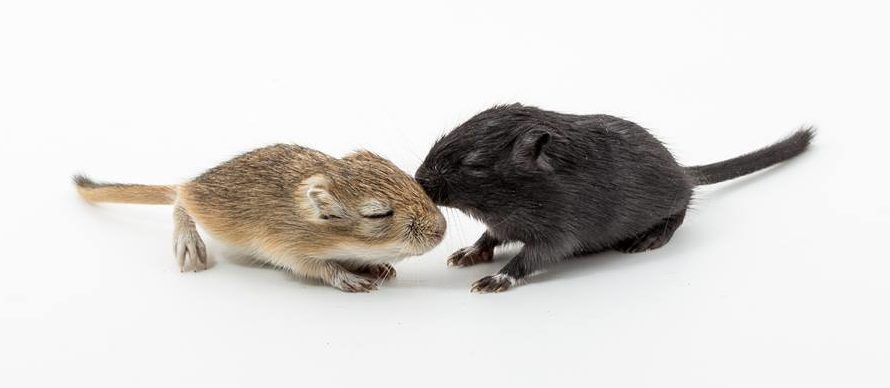(self) Black: aa C* D* E* P* Uw*
Black is the name of the main alternate coat color of the Mongolian gerbil (the genetic pair of Agouti) and is where the whole coat is black, including the tummy. They often have tiny white spots on their chins, chests and feet.

Many wild animals including rodents have this alternate coloring – including both Black gerbils and Black Panthers.
Basically they are melanistic (have too much melanin (a black pigment in their hairs which covers up all other colors but can leave patterning)). In many animals – this dark coloring can also suit their habitat leaving them slightly camouflaged in their environments. However, in many places like in a desert (like for a gerbil) or on snow, this new color makes them stand out like a sore thumb and they are soon picked off by predators.
Black coats in gerbils do not have the normal ‘ticked’ appearance of the agouti-based colours as the ticking is from the different colors in the hair and the distinctive black tips – but of course you can’t see the black tips on the black coat anyway – so the coat appears smooth or solid.
Because there is no Agouti gene here to add color to the hairs or the tummy, these gerbils are called non-agouti, black-based or self colors.

The recessive gene that causes this, labelled as [a], also cancels out the normal white stomach of the agouti-based color, so they are 99% Black when they are Black. (Image above shows white speckles on an older Black gerbil)
The only time a Black gerbil isn’t Black though – is when it is spotted.
The presence of the Dominant Spotting gene on the coat will be displayed as a large amount of white fur on the gerbil usually on the nose, forehead and nape of the neck – and even if these patches are rather small – there will always be a large patch of white on the tummy (usually around the chest) as the Dominant Spotting gene strips away the ability of the melanin to make all of the tummy black.
This amount of white though, will never be the same as the amount of white on an agouti-based gerbil tummy as that is created in a certain place by a certain gene.
I’m not sure it IS Black yet?
There is only one other color your gerbil could be if it isn’t Black and that is Slate.
Slates are a slightly duller black than Black gerbils, but with spotting and other recessive genes in the mix it isn’t always very clear just from looking at one on its own. If you had two or more side by side you can often see the difference more easily – but it isn’t fail safe.
But it really doesn’t matter anyway to most people who are just having them as pets.
You might even think your gerbil is Black (for years) even if it is actually Slate – as there is really no easy way of telling them apart – but unless you are wanting to breed specific colours like Burmese and Siamese or Cream and Silver Nutmegs it doesn’t really matter what you think they are.
There is only really one way to tell them apart visually if you don’t know their genes and this is in the reflection of their eyes when using flash photography *NEVER flash a camera flash directly into the eyes of any gerbil (or human).
Slate gerbils (as with all other uwᵈuwᵈ gerbils) have what is termed ‘ruby eye shine’ when photographed – and so do colorpoint gerbils. So when taking ordinary distant pictures of your gerbils where their eyes are open – you may well notice over all the images that this gerbil always has a strong ruby eye shine and so you could almost certainly say they were a Slate gerbil.
Breeding them to an AA uwᵈuwᵈ gerbil (like Grey Agouti and Polar Fox) is the only way to be 100% sure – as this eliminates the chances of more Blacks confusing the mix. Using this logic, if it wasn’t a Slate you had – you would get Agouti pups from the cross. If it was a Slate you wouldn’t get any Agoutis (as the uwᵈs would match up).
You have Black gerbils you want to Breed?
Due to the prevalence of all the dominant genes needed to create a Black gerbil, this color is one of the most commonly seen in litters of pups alongside Agouti. It is much easier to get a Black pup from random genes than it is to get a Silver Nutmeg for example.
Genetics-wise, the genes for a Black gerbil are so ‘strong’ (virtually all gerbils carry them and you only need one set of recessives), that if you mate a Black gerbil to any other color gerbil on the self side, you will always get Black pups in the mix.
Also, if you mate a Black gerbil to an agouti-based gerbil who had at least one non-agouti parent, you will also get a high percentage of Blacks due to these ‘strong/easy-to-find’ genes.
You want Black Pups?
Very handy indeed – they are very easy to produce (and well liked buy buyers).
There are loads of different ways to get Black pups in your litters depending on the colors you already have and the genes you already know about. Quite often Agouti and Black pups are found in the same litters as they are complementary colors partners.

If you want Black pups you would need to simply breed two Black gerbils together – but they may have a whole host of recessive colors in there. The one thing you will never get from two Black gerbils is an Agouti gerbil. You can’t carry the dominant A gene for agouti coats – so once you are a Black (or self-based ) gerbil – you can’t make anything other than more self-based gerbils.
So back to Blacks. You would firstly need to only breed gerbils on the black-based or self-based side of colors – basically do not breed any agouti-based colors or any double-sided colors (colors that could actually be either A* or aa but you can’t tell by just looking) – for example Pink-Eyed Whites (PEWs), Himalayans, or Black-Eyed Whites (BEWs) unless you definitely know their parentage.
By eliminating the dominant Agouti gene [A] you are doubling your chances of getting Blacks.
If your Black gerbil had all the dominant genes in both pairs [aa CC DD EE PP UU] then, no matter what other [aa] gerbil you bred them with, you would ALWAYS get 100% Black pups – and only Black pups.
Breeding a Black gerbil – even with unknown genes – will always create more Blacks (if the gerbil you breed it with hasn’t got AA genes).
Also avoid breeding from gerbils with red/ruby/pink eyes (as Black gerbils can’t have pink eyes), Adding genes a Black gerbil doesn’t need only increases the chances of getting other colors in your litters (therefore reducing the chances of getting the colors you actually want) – so avoid breeding into your line colorpoint gerbils, Honeys and Foxes and underwhite gerbil colors for the same reason.
And finally – avoid breeding any gerbils together with more than one set of recessives the same. Gerbils like Silver Nutmegs (ee+uwᵈuwᵈ), CP Slates (c*c*+uwᵈuwᵈ) and PEWs (c*c*+pp) are all out because they can put into your gene pool genes that will stop you getting black pups. And they have lots of genes to put in.
These combinations don’t stop you getting Black gerbils of course, they just lower the amount of them that you will get by simply adding in loads of alternate colors. It’s like adding more fruit to the fruit bowl – you just increase the variety. But if you just wanted bananas….
Don’t have Black gerbils – but want them?
If you don’t have any Black gerbils of your own but definitely want to create them – you could try one of the 3 following plans to get them…
1) Breed any shade of silver gerbil (Lilac/Sapphire/Dove) with any [aa] dark-eyed gerbil (best)
2) Breed any two black-based dark-eyed gerbils without the same double recessives* (very good)
3) Breed any black-based gerbil with a Golden Agouti* (could be good)
*If you breed a Burmese to a Silver Nutmeg – you will get anywhere up to 100% Black pups; if you breed a Siamese to a Slate – it is the same, plenty of Black pups. However, if you breed a Burmese to a Siamese or a Slate to a Silver Nutmeg – you won’t get any Black pups. Can you figure out why?
**Ideally this Agouti would have a black-based parent itself – or at least the chance of it carrying an [a] gene – otherwise you won’t get any Black gerbils at all – but if it does have the hidden [a] gene you will get up to 50% Black pups.
Don’t want Black pups in your litters?
The only ways you can be sure of NOT getting Black pups in your litter are basically the opposite of above:
Use a pair of gerbils which both carry the SAME recessive genes
This would mean something like breeding 2 ee gerbils together (like a Red Fox/Saffron and a DEH; or a Nutmeg and a Polar Fox). If both parents do not carry the dominant [E] version of this gene – you can’t ever get Black pups from that pairing even if you use both [aa] parents. Same goes for breeding 2 pink-eyed gerbils together; a Black gerbil can’t have red eyes so you will never get one in your litters.
Only breed Agouti-based colours – ideally where one parent carries AA
This will ALWAYS exclude Blacks (and all other black-based colors from your litters). You can use any agouti-based colors as parents for these pairings – as long as at least one of them is [AA], so Polar Fox to any Argente; Grey Agouti to DEH, etc. Your pups will still carry the [a] gene from these crosses of course, so to establish a good non-self line going forward – ideally find two parents that are both AA and all the pups will be AA too. No Black gerbils ever again…
Using either of these techniques above also limits the number of other colors you will get overall too, but once you start breeding and seeing the pups, you can write down your expressed genes and work out who is best for what further down your line.
For more information about Breeding for Color please do read on…